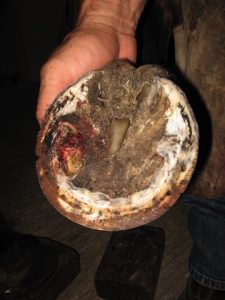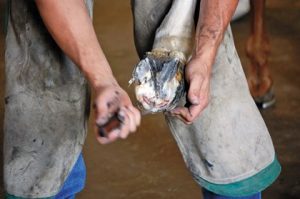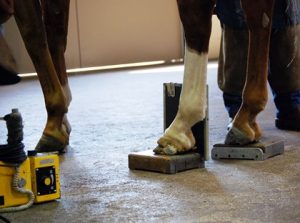
Photo: The Horse Staff
A hoof abscess is like a whitehead pimple:
That little bubble of pus under the skin can be slightly sore or it can be incredibly painful, and the fastest way to get rid of it is to pop it and let it drain.
This common problem can cause sudden , severe lameness, but it often can be resolved quickly with proper treatment approach.
Yesterday your horse was perfectly sound, but today he won’t touch one foot to the ground. There is no apparent injury or sign of a problem in his leg or hoof other than the sudden, severe lameness. What could have happened?
One strong possibility for the cause of this scenario is a hoof abscess–a localized accumulation of pus within the horse’s hoof. The good news is that the abscesses can often be resolved quickly and easily with proper veterinary care and leave no lasting damage. Even better, practicing good routine hoof care and management can usually prevent them.
As an owner, how do you prevent abscesses and what do you do if your horse gets one? First let’s discuss what they are and what causes them.
The simplest comparison we can make to define a hoof abscess is that it’s like a whitehead pimple. That little bubble of pus under the skin can be slightly sore or it can be incredibly painful. You might feel soreness in that location well before the pimple shows it’s ugly head, or it might show up overnight in all it’s glory. And the simplest way to get rid of it is simply to pop it and let it drain; the pain relief is immediate because the pressure has been relieved.
This is the same way a hoof abscess causes pain in a horse; it usually starts with a localized, walled-off infection, which the body fights with white blood cells and inflammatory mediators. The buildup of infection, inflammation, and white blood cells expands, causing increasing pressure, particularly because the rigid hoof wall can’t expand to relieve the pressure. When lameness appears and how severe the lameness becomes will vary. Some Horses might never get lame before the abscess ruptures on its own, or lameness might be transient and go unnoticed, especially if the horse is at pasture and not monitored often.
Most abscesses begin with bacteria entering interior hoof structures, usually via the sole-wall junction (just inside the hoof wall). Anything that weakens hoof/sole integrity can make it easier for bacteria to invade, and internal hoof injuries (such as bruising) can also result in abscesses. Following is a list of common causes:
Environmental Conditions cycling between wet and dry
In very dry conditions the hoof dries out and can shrink slightly like a dried-out sponge. This can result in tiny hoof cracks and fissures in the sole-wall junction that can then soften and fill with muck when the weather turns wet, allowing opportunistic bacteria to invade the hoof and cause an abscess.
Penetrating wounds can occur as a result of a horse stepping on a sharp object such as a nail, rock, or broken glass. “These may cause a perforation of the sole that packs up and seals over, and an abscess results two to four days later as a result of contamination,” says Bruce Lyle, DVM, of the Aubrey Equine Clinic in Aubrey, Texas.
“Close” nails in a recently shod foot
Raul Bras, DVM, of Rood & Riddle Equine Hospital in Lexington,Kentucky, explains that a horseshoe nail placed too close to or into the foot’s sensitive inner structures can introduce bacteria that cause an abscess.. Even if the nail is removed right away and didn’t introduce bacteria, it created a pathway into the hoof that can let in bacteria and result in an abscess later. Bras recommends flushing the hole with dilute antiseptic solution, such as Betadine, and wrapping the foot for three to five days (depending on the horse’s turnout situation) to decrease the chances of infection.
Ground conditions/bruising
Muddy or rocky ground can soften feet and/or cause bruises. “Some non-penetrated bruises may abscess if bacteria are introduced through a small external insult or from circulating bacteria in the bloodstream, because the area of hemorrhage provides a great medium for bacterial reproduction,” Lyle says.
Hot-fitting a shoe on a very thin sole
Lyle says if the sole is very thin and a hot shoe is seated on it, thermal injury to the underlying sensitive tissues can sometimes cause a sterile abscess (not caused by infection). Applying exothermic (heat-producing) hoof repair materials over raw or partly healed areas can do the same thing
Poor hoof balance/conformation
For example, hoof wall flares can put additional bending stress on the sole-wall junction and cause cracks that can become contaminated. Also, Lyle says leaving the bars on the foot too long (or leaving any part of the foot longer so it gets more of a beating) can result in localized bruising and abscesses.
Dirty stalls tend to be wet and contain lots of bacteria that can invade the foot. “Wet conditions are usually the culprit in our area, especially when preceded by dry conditions,” says Lyle.
Bras notes that hoof/wall capsule defects can also make it easier for bacteria to invade, as can digital instability (such as that resulting from severe laminitis) or systemic infections. With the latter, bacteria in the bloodstream get into the foot tissues and “set up shop,” causing an abscess from within.
“Clinical signs depend on the severity of the infection; therefore, lameness could vary from mild, minimal lameness progressing to moderate, severe lameness,” says Bras. “Other clinical signs might include swelling, heat, draining tracts (pus, often gray or black in color, from the sole.coronary band), increased digital pulse, and evidence of hood injuries (that can introduce bacteria into inner hoof structures, leading to abscesses)”.
In severe cases deep within the hoof, the abscess pocket or its effects, such as deteriorating bone, are visible on a radiograph.
“A hoof tester exam applying focal force is often vital to localizing an abscess within the confines of the foot,” says Lyle. “As the pressure increases, so does the pain.”
Also, when trimming the foot one might see a black spot on the sole or sole-wall junction where a crack or puncture is contaminated with muck. This stands out in contrast to the rest of the clean, trimmed sole. This contaminated tract might lead to an abscess (not all contaminated cracks will cause abscesses). Bras notes that most abscesses can be found this way.
Similar to treating pimples, the basic abscess treatment strategy is to open it and let it drain. Some will even pop on their own, often after traveling up the hoof to the coronary band or heel bulbs where the wall is thinner and easier to break through.
When possible, a veterinarian drains an abscess through the sole for two reasons: One, the cack or puncture that can lead to an abscess generally is in the sole, and it can be followed to the abscess. Two, this puts a hole beneath the abscess so gravity can help pull out the pus. Cleanliness is essential during and after the procedure.
“Treatment requires cleaning the foot, locating the entry wound (if there us one), establishing drainage, softening the hoof capsule via foot soaks and poultices to encourage rupture/drainage, and keeping the foot wrapped and protected from further debris entering causing further infection,” says Bras. “Anti-inflammatory medication and antibiotics may also be given if needed. After drainage is obtained, progressive improvement should be expected on a daily basis. “I f drainage and lameness continue, perform other diagnostic procedures to determine the true cause.
“Good hoof care that leaves adequate sole for protection and develops a snug and uniform sole-wall junction is the best line of prevention,” says Lyle.
Good hoof care includes frequent hoof cleaning to remove rocks/mud and routine farrier care to keep the feet balanced and address any problems.
“If a horse has thin soles or is prone to bruising…protect them with shoes, etc.,” says Bras. “Keep the feet trimmed so they don’t get wall separations that can lead to white line disease and abscesses. Be proactive; don’s wait for things to happen.”
Lyle explains, “The most important thing to know about abscesses is to get your lame horse looked at as early in the process as possible by a veterinarian who’s interested in horses. Abscesses generally are straightforward and shouldn’t require extravagant and expensive imaging to diagnose or treat, although exceptions do exist.”
THE AUTHOR: CHRISTY M. WEST:
Christy has a BS in Equine Science from the University of Kentucky, and an MS in Agricultural Journalism from the University of Wisconsin-Madison



